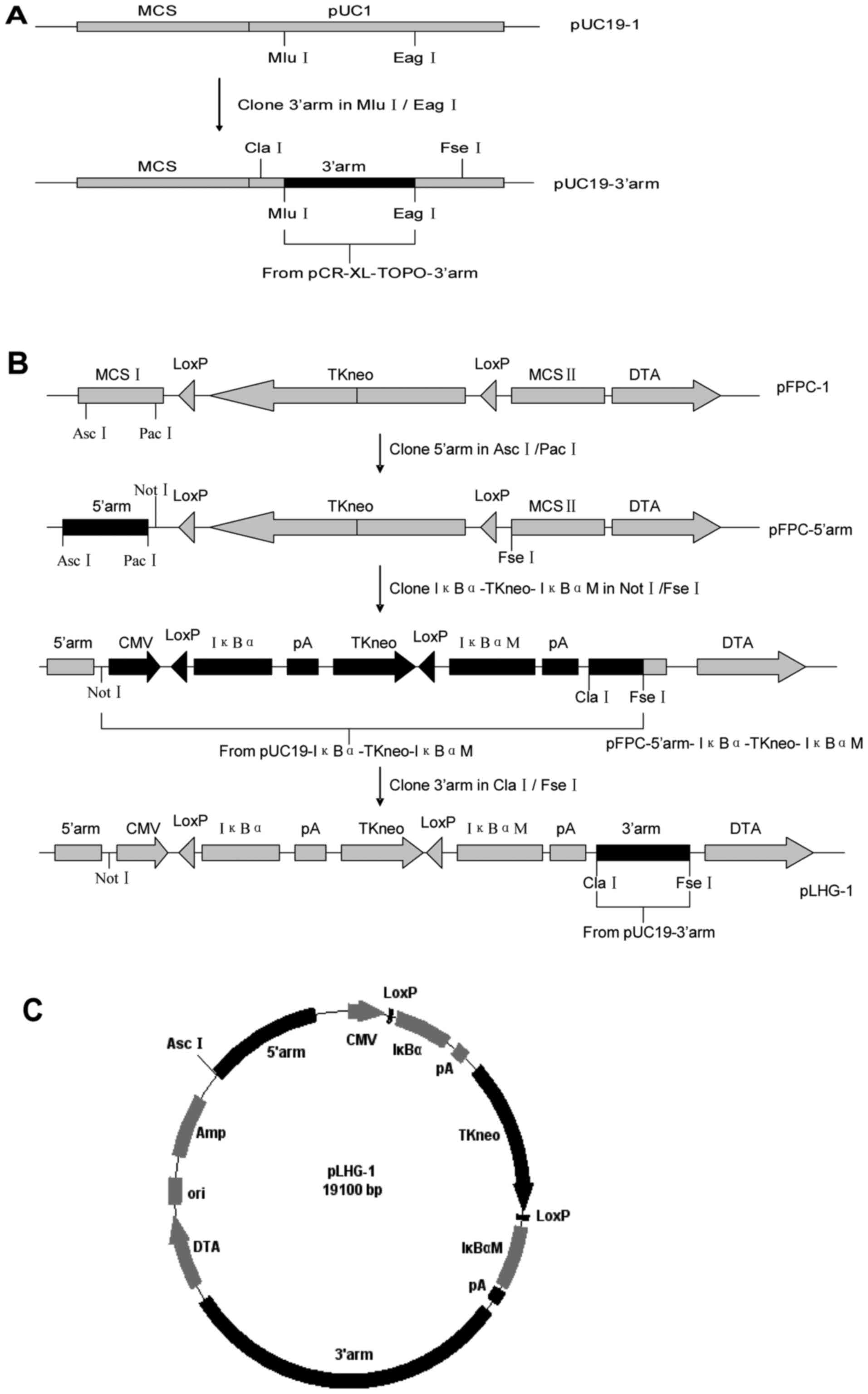|
1
|
Le Bas-Bernardet S, Anegon I and Blancho
G: Progress and prospects: Genetic engineering in
xenotransplantation. Gene Ther. 15:1247–1256. 2008. View Article : Google Scholar : PubMed/NCBI
|
|
2
|
Mohiuddin MM: Clinical xenotransplantation
of organs: Why aren't we there yet? PLoS Med. 4:e752007. View Article : Google Scholar : PubMed/NCBI
|
|
3
|
Auchincloss H Jr and Sachs DH: Xenogeneic
transplantation. Annu Rev Immunol. 16:433–470. 1998. View Article : Google Scholar : PubMed/NCBI
|
|
4
|
Hayden MS and Ghosh S: Shared principles
in NF-kappaB signaling. Cell. 132:344–362. 2008. View Article : Google Scholar : PubMed/NCBI
|
|
5
|
Cheong R, Hoffmann A and Levchenko A:
Understanding NF-kappaB signaling via mathematical modeling. Mol
Syst Biol. 4:1922008. View Article : Google Scholar : PubMed/NCBI
|
|
6
|
Traenckner EB, Pahl HL, Henkel T, Schmidt
KN, Wilk S and Baeuerle PA: Phosphorylation of human I kappa
B-alpha on serines 32 and 36 controls I kappa B-alpha proteolysis
and NF-kappa B activation in response to diverse stimuli. EMBO J.
14:2876–2883. 1995.PubMed/NCBI
|
|
7
|
Gerondakis S, Grumont R, Gugasyan R, Wong
L, Isomura I, Ho W and Banerjee A: Unravelling the complexities of
the NF-kappaB signalling pathway using mouse knockout and
transgenic models. Oncogene. 25:6781–6799. 2006. View Article : Google Scholar : PubMed/NCBI
|
|
8
|
Perez-Campo FM, Spencer HL, Elder RH,
Stern PL and Ward CM: Novel vectors for homologous recombination
strategies in mouse embryonic stem cells: An ES cell line
expressing EGFP under control of the 5T4 promoter. Exp Cell Res.
313:3604–3615. 2007. View Article : Google Scholar : PubMed/NCBI
|
|
9
|
Goodman DJ, von Albertini MA, McShea A,
Wrighton CJ and Bach FH: Adenoviral-mediated overexpression of
I(kappa)B(alpha) in endothelial cells inhibits natural killer
cell-mediated endothelial cell activation. Transplantation.
62:967–972. 1996. View Article : Google Scholar : PubMed/NCBI
|
|
10
|
Wrighton CJ, Hofer-Warbinek R, Moll T,
Eytner R, Bach FH and de Martin R: Inhibition of endothelial cell
activation by adenovirus-mediated expression of I kappa B alpha, an
inhibitor of the transcription factor NF-kappa B. J Exp Med.
183:1013–1022. 1996. View Article : Google Scholar : PubMed/NCBI
|
|
11
|
Gareus R, Kotsaki E, Xanthoulea S, van der
Made I, Gijbels MJ, Kardakaris R, Polykratis A, Kollias G, de
Winther MP and Pasparakis M: Endothelial cell-specific NF-kappaB
inhibition protects mice from atherosclerosis. Cell Metab.
8:372–383. 2008. View Article : Google Scholar : PubMed/NCBI
|
|
12
|
Henke N, Schmidt-Ullrich R, Dechend R,
Park JK, Qadri F, Wellner M, Obst M, Gross V, Dietz R, Luft FC, et
al: Vascular endothelial cell-specific NF-kappaB suppression
attenuates hypertension-induced renal damage. Circ Res.
101:268–276. 2007. View Article : Google Scholar : PubMed/NCBI
|
|
13
|
Kisseleva T, Song L, Vorontchikhina M,
Feirt N, Kitajewski J and Schindler C: NF-kappaB regulation of
endothelial cell function during LPS-induced toxemia and cancer. J
Clin Invest. 116:2955–2963. 2006. View
Article : Google Scholar : PubMed/NCBI
|
|
14
|
Ye X, Ding J, Zhou X, Chen G and Liu SF:
Divergent roles of endothelial NF-kappaB in multiple organ injury
and bacterial clearance in mouse models of sepsis. J Exp Med.
205:1303–1315. 2008. View Article : Google Scholar : PubMed/NCBI
|
|
15
|
Iiizumi S, Nomura Y, So S, Uegaki K, Aoki
K, Shibahara K, Adachi N and Koyama H: Simple one-week method to
construct gene-targeting vectors: Application to production of
human knockout cell lines. Biotechniques. 41:311–316. 2006.
View Article : Google Scholar : PubMed/NCBI
|
|
16
|
Wu S, Ying G, Wu Q and Capecchi MR: A
protocol for constructing gene targeting vectors: Generating
knockout mice for the cadherin family and beyond. Nat Protoc.
3:1056–1076. 2008. View Article : Google Scholar : PubMed/NCBI
|
|
17
|
Capecchi MR: Altering the genome by
homologous recombination. Science. 244:1288–1292. 1989. View Article : Google Scholar : PubMed/NCBI
|
|
18
|
Vasquez KM, Marburger K, Intody Z and
Wilson JH: Manipulating the mammalian genome by homologous
recombination. Proc Natl Acad Sci USA. 98:8403–8410. 2001.
View Article : Google Scholar : PubMed/NCBI
|
|
19
|
Sorrell DA and Kolb AF: Targeted
modification of mammalian genomes. Biotechnol Adv. 23:431–469.
2005. View Article : Google Scholar : PubMed/NCBI
|
|
20
|
Ikeya M, Kawada M, Nakazawa Y, Sakuragi M,
Sasai N, Ueno M, Kiyonari H, Nakao K and Sasai Y: Gene
disruption/knock-in analysis of mONT3: Vector construction by
employing both in vivo and in vitro recombinations. Int J Dev Biol.
49:807–823. 2005. View Article : Google Scholar : PubMed/NCBI
|
|
21
|
Zhang P, Li MZ and Elledge SJ: Towards
genetic genome projects: Genomic library screening and
gene-targeting vector construction in a single step. Nat Genet.
30:31–39. 2002. View
Article : Google Scholar : PubMed/NCBI
|
|
22
|
Liu P, Jenkins NA and Copeland NG: A
highly efficient recombineering-based method for generating
conditional knockout mutations. Genome Res. 13:476–484. 2003.
View Article : Google Scholar : PubMed/NCBI
|
|
23
|
Cotta-de-Almeida V, Schonhoff S, Shibata
T, Leiter A and Snapper SB: A new method for rapidly generating
gene-targeting vectors by engineering BACs through homologous
recombination in bacteria. Genome Res. 13:2190–2194. 2003.
View Article : Google Scholar : PubMed/NCBI
|
|
24
|
Nyabi O, Naessens M, Haigh K, Gembarska A,
Goossens S, Maetens M, De Clercq S, Drogat B, Haenebalcke L,
Bartunkova S, et al: Efficient mouse transgenesis using
Gateway-compatible ROSA26 locus targeting vectors and F1 hybrid ES
cells. Nucleic Acids Res. 37:e552009. View Article : Google Scholar : PubMed/NCBI
|












